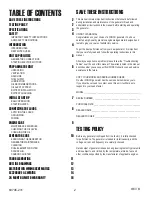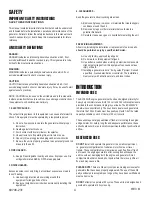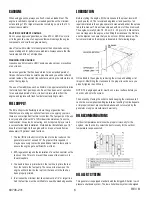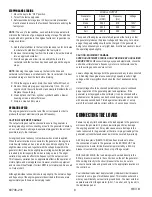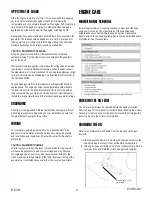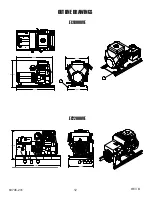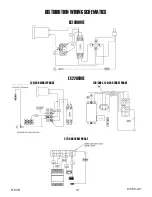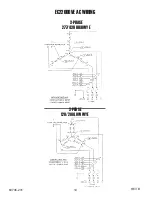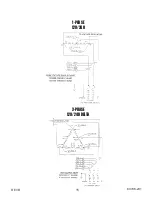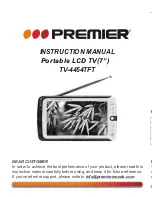
8
REV B
60706-231
STOPPING AND STORING
1. Move the key to the “OFF” position.
2. Turn off the fuel supply valve.
3. Before extended storage (over 30 days) certain precautions
must be taken to ensure the fuel doesn’t deteriorate and clog the
fuel system.
NOTE:
The use of a fuel additive, such as Sta-Bil or equivalent will
minimize the formation of gum deposits during storage. The additive
may be added to gasoline in the engines fuel tank or to gasoline in a
storage container.
A. Add the fuel stabilizer to the fuel in the tank and run for 2 minutes
to circulate the stabilizer throughout the fuel system.
B. Remove the remaining fuel from the fuel tank, it must be drained
into an approved container.
C. Start the engine and allow it to run until all the fuel in the
carburetor and the fuel lines has been used up and the engine
stops.
NOTE:
Running the engine to use up the fuel in the lines and
carburetor will still leave a small amount of fuel in carburetor. It is best
extended storage to treat the fuel before draining.
D. While the engine is warm, drain the oil and refill with fresh oil.
E. Remove the spark plug, pour approximately 1/2 oz. (15cc) of
engine oil into the cyclinder and crank slowly to distribute the oil.
Replace the spark plug.
E. Clean dirt and chaff from cylinder, cylinder head fins, blower
housing, screen, and muffler areas.
F. Store in a clean and dry area.
OPERATING SPEED
The engine-generator must be run at the correct speed in order to
produce the proper electrical voltage and frequency.
CAUTION: EQUIPMENT DAMAGE
The output voltage should be checked to ensure the generator is
working properly prior to connecting a load to the generator. Failure to
do so could result in damage to equipment plugged into the unit and
possible injury to the individual.
All engines have a tendency to slow down when a load is applied.
When the electrical load is connected to the generator, the engine is
more heavily loaded, and as a result, the speed drops slightly. This
slight decrease in speed, together with the voltage drop within the
generator itself, results in a slightly lower voltage when the generator
is loaded to its full capacity than when running no load. The slight
variation in speed also affects the frequency of the output current.
This frequency variation has no appreciable effect in the operation of
motors, lights, and most appliances. However, electronic equipment
and clocks will be affected if correct RPM is not maintained. See Load
vs. Output chart.
Although individual units and models vary slightly, the normal voltage
and frequency of the engine-generator described in this manual are
approximately as follows, under varying loads:
LOAD vs. OUTPUT
Generator
Load
Speed
(RPM)
Frequency
(Hz)
Voltage
None
3690
61.5
125V
Half
3600
60.0
120V
Full
3510
58.5
115V
The speed of the engine was carefully adjusted at the factory so that
the generator produces the proper voltage and frequency. For normal
usage, the speed setting should not be charged. If the generator is
being run continuously on a very light load, it is often advisable to lower
the operating speed slightly.
CAUTION: EQUIPMENT DAMAGE
SPEED ADJUSTMENTS SHOULD ONLY BE MADE BY A QUALIFIED
SERVICE TECH. Whenever making any speed adjustments, check the
unit with a voltmeter and a frequency meter or a tachometer and be
sure the voltage and speed are correct.
Lower voltage may damage both the generator and any load connected
to it. Running the engine at excessively high speeds results in high
voltage, which may significantly shorten the life of appliances being
used.
Output voltage should be checked periodically to ensure continued
proper operation of the generating plant and appliances. If the
generator is not equipped with a voltmeter, it can be checked with a
portable meter. Frequency can be checked by using an electric clock
with a sweep second hand. Timed against a wrist watch or a stop
watch, the clock should be correct /- 2 seconds per minute.
CONNECTING THE LOADS
Failure to properly limit and balance the load applied to the generator
will cause the generator to produce low voltage and may damage
the engine generator set. It may also cause severe damage to the
loads connected to the generator at the time. Improper loading of the
generator set constitutes abuse and will not be covered by warranty.
A 60 Amp receptacle (NEMA 14-60) has been provided to allow
the connection of loads to the generator on the EC18000VE. This
receptacle is a 4-wire, full load receptacle protected by a 60 Amp
breaker mounted in the control box on top of the generator.
With the EC22000VE, the load wiring must be wired directly in the
80 Amp breaker mounted in the control box on thop of the generator.
When wiring directly to the circuit breaker in the box, be sure to
connect a neutral wire and ground wire to the appropriate locations in
the control box.
Your individual loads must be protected by individual circuit breakers
mounted in some type of distribution panel. This location will also be
where you will install your neutral to ground bond. You must wire four
separate wires from the generator (2-hot, 1- neutral, and 1-ground) to
the distribution panel.


